


Many of the missile silos in Weld County are in the New Raymer Fire District. The fire department covers 1,100 square miles and has dozens of missile silos within its boundaries.It took five days to discover this fire that did $1 million in damage in a Minuteman III multiple-warhead atomic missile silo? Holy Crap! And it burned a box of shotgun shells?
“Our department has been trained about missile silos and fire,” said new Raymer Fire Chief Cyle Lambert. “The Air Force comes out and trains us, but they pretty much say they’re in charge if there’s a fire.”
Lambert said firefighters in New Raymer are only trained to respond to the manned silos — there are two of them in the fire protection district — and they are not to respond to the unmanned silos. The arrangement for missile silos is to have one manned silo commanding the launch of as many as 10 unmanned silos.
“Probably our biggest worry about the silo fires,” Lambert said, “is that a wildland fire could spread over a silo. But we’ve been assured it wouldn’t cause any kind of serious accident.”
Arellano says the fire was caused by a faulty battery and extinguished itself from a lack of fuel after an hour or two. It burned a box of shotgun shells, a shotgun and a shotgun case that were kept in the room, but the Air Force investigative report did not mention any debris from the shells, Arellano said.
Damage was estimated at $1 million, including replacing damaged equipment and cleanup.

Organizers say the Aerial Firefighting Conference 2008, which took place in Athens, Greece on October 22-23, was highly successful. Organized by Tangent Link Ltd, the first annual conference was attended by twenty-two nations.
The conference was chaired by Johann Goldhammer of the Global Fire Monitoring Center and Rear Admiral Terry Loughran. The agenda included fixed and rotary winged operations, safety, management and technologies; subjects which dominated the vibrant conference.
Many interagency meetings ensued to discuss and debate how to tackle wildfires from the air and how international aerial fire fighting management organizations can improve and share their knowledge and systems. An exhibition of some of the worlds' leading operators and suppliers was held simultaneously; the exhibition drew considerable interest from the delegates and provided a focal point for many of the accompanying discussions.
Panel sessions took place on Air Pollution from Aerial Firefighting and a debate was hosted by Chris Allen from the EU-Civil Protection Directorate on whether Europe should finance a cross-border aerial fire fighting squadron. Leading exponents took part in the debate including Tom Harbour, Director, Aviation United States Forest Service (USFS, USA), Shane Fitzsimmonds, Commissioner NSW Rural Fire Service (Australia), Dave Bokovay, Aviation Manager CIFFC (Canada) and Colonel Fernando Pastor Villar, Commander 43rd Group Spanish Air Force (Spain).
Two new upcoming events were announced at the conference. The Aerial Firefighting USA Conference is scheduled to take place in Anaheim, CA on February 19-20, 2009 at the Crowne Plaza Hotel. The event is supported by UN-ISDR and the Global Fire Monitoring Center, and sponsored by Bombardier.
The second event is a one-day Aerial Firefighting Australasia Conference taking place in conjunction with the New South Wales Rural Fire Services' "International Wildfire Management Conference 2009" taking place in Sydney, Australia -- the largest fire fighting management event of its kind in the Australasia region.
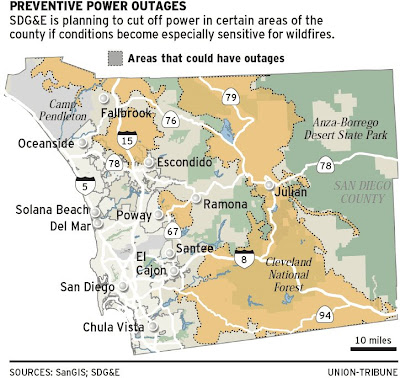
As far as we know, this is an unprecedented plan, turning off power to large areas because the lines may start a fire during strong winds. They may be hoping that by scaring the public about losing their power, the state legislature will exempt the company from liability.
The scare-the-public tactic works for the Bush administration. It may work for SDG&E.
Monday night between 8 and 10 p.m., firefighters began a firing operation out ahead of the fire, between the fire and Concow. CalFire-Butte County Capt. Scott McLean said the firing was going well, until an unexpected change in the weather occurred after midnight. Strong down canyon winds and a drop in the relative humidity from 43% to 21% caused spot fires far ahead of the firing operation.Today there is an interesting article at ParadisePost.com that tells the story of one of the residents of Concow who was forced to evacuate by two different fires that month. It has a happy ending.... his home was spared by the fire.
McLean said:We had to try something; the fire was going to get there anyway.On Tuesday the fire reached Concow and burned at least 50 homes. We don't fault the firefighters.... we will take the spokesperson at his word, that the fire would have reached Concow anyway. The strong winds Monday night and Tuesday contributed to the extreme fire behavior that caused the fire to burn all the way to the outskirts of Paradise.

The UCLA researchers are confident in their findings because the underlying conditions that create the most powerful of Santa Ana winds have been well documented both observationally and in equations. As these fall and winter winds roar through mountain passes, in areas such as Simi Valley, they are powered by a spillover effect from a huge dome of high pressure air that builds up in the high desert area known as the Great Basin, in eastern California, Nevada and Utah.
The vast airflows are drawn to low-pressure areas to be found over the ocean off the coast near Los Angeles, like water in a stream moving downhill.
But it’s not just the difference in elevation and air pressure between the high desert and the ocean that fuels these winds. “Temperature forcing” also plays a crucial role, and as the land warms more quickly than in the past, in the fall and early winter, this forcing loses some of its power. With a physics calculation, Hall’s team finds that this factor has fallen by about one-third, resulting in a slow but steady downtrend in the most dangerous winds.
“This is not a small effect,” Hall said. “It’s a well-known fact that the cool air that forms over the desert at night is part of the Santa Ana condition, and so, as the interior of California warms, the difference between the desert and the ocean air pressures is reduced. That’s why we’re seeing fewer Santa Ana conditions over Southern California, and why we should continue to see fewer until the warming of the ocean catches up to the warming of the land, which won’t be until sometime in the 22nd century.”
WOODLAND, Calif. --A reserve firefighter has been found guilty of intentionally starting wildfires that he later battled.
Robert Eric Eason, 30, was convicted of 14 counts of arson. Eason was accused of setting a series of 16 wildland fires in the Capay Valley from 2005 to 2006, the district attorney's office said.
Many of the fires caused considerable damage to farmland and livestock, including one blaze that killed several hundred sheep.
A jury reached its verdict after just one day of deliberation. Eason faces up to 50 years in prison.
Forest fires in the (California) Sierra Nevada have grown larger, more frequent and more damaging in the last two decades, according to a study that suggests much of the blame rests with the government's century-long war on wildfire.
The study, published online this month in the journal Ecosystems, found that between 1984 and 2006, the proportion of burned areas where no trees survived increased, on average, to nearly 30%, from 17%.
Climate is playing some role, the study said. But it blamed a bigger factor: Federal efforts to quench most blazes quickly have thwarted the Sierra Nevada's natural cycle of frequent, house-cleaning fires and left forests packed with fuel.
"This just blind effort to continue to put everything out is probably backfiring on us," said Hugh Safford, a U.S. Forest Service ecologist and one of the study's authors. "We've created our own nightmare."
Blazes in mid- and low-elevation forests have grown more severe in large part because there is more to burn. A jump in average annual precipitation across the range since 1908 has promoted forest growth, while a rise in temperature is diminishing the mountain snowpack and lengthening the fire season.
The study, based on satellite imagery of the Sierra and southern Cascade ranges, also found that the average size of severely burned forest patches caused by individual fires has roughly doubled in recent decades.
"It may simply be that most low- and middle-elevation forest lands in the study region are ready and primed to burn," the researchers wrote.
 Briefly, a controlled burn by Brown in 2004 escaped and burned 20 acres of U.S. Forest Service land. He was ordered to pay restitution but initially refused. Eventually he paid a reduced fine of $4,747 in April, but only after ensnaring dozens of federal employees in a conflict that cost the government an estimated $100,000 to resolve. Undersecretary of Agriculture Mark Rey was accused of making decisions about the case based on politics.
Briefly, a controlled burn by Brown in 2004 escaped and burned 20 acres of U.S. Forest Service land. He was ordered to pay restitution but initially refused. Eventually he paid a reduced fine of $4,747 in April, but only after ensnaring dozens of federal employees in a conflict that cost the government an estimated $100,000 to resolve. Undersecretary of Agriculture Mark Rey was accused of making decisions about the case based on politics.Jack Gregory, a 36-year veteran of the U.S. Forest Service, will speak in Myrtle Beach at 2 p.m. today about the fire set by U.S. Rep. Henry Brown in 2004 that burned down 20 acres of Francis Marion National Forest. Gregory will appear at Nance Plaza in downtown Myrtle Beach, across from the former Pavilion site.Brown is running for re-election, for a fifth term, and this fire has become an issue in the campaign. His opponent, Linda Ketner, has a TV ad that features the fire and Brown has demanded that Ketner stop showing the ad. Ketner has refused.
[...] Brown's campaign manager Rod Shealy said Brown had a burn permit and the Forest Service was also starting burns. In both cases, the burns were designed to clear away underbrush that, if allowed to build up, could provide fuel for even larger fires. The alert wasn't issued until late in the day when Brown's fire was already ignited, he said.
Ketner has posted a whistleblower report from the U.S. Forest Service on her campaign web site that said a state Forestry Commission officer had told Brown earlier in the day that he should not burn, despite the permit.
The report also says Brown told U.S. Forest Service officials shortly afterward their programs might get more scrutiny if they pursued the fine. Brown is a member of the House Natural Resources Committee.
The dispute was resolved earlier this year, and Brown paid almost $5,000. The government also revised its policy on controlled burns.
Brown said he fought the fine because the law needed to be changed.
Under the old law, if a fire spread from Forest Service property to private land, landowners had to prove government neglect to get compensated. But fires spreading from private land to a national forest were automatically an offense, he said.
"We got that changed," Brown told Ketner during a debate last week.
But Ketner said that in the previous year 15 people were fined for fires spreading to the forest and all paid.
"It would have been so much better if you had done it on behalf of them instead of yourself," she said.
The National Parks and Wildlife officer from Port Macquarie was fighting a fire, suspected of being deliberately lit, in the Kumbatine National Park, about 26km south-west of Kempsey.Our condolences to the family and coworkers of Mr. Laut.
He was killed instantly about 6pm on Sunday when a tree fell on him as he was assisting a back burning operation in the remote national park.
The national park covers 13,000ha and is a protected area. Following the death, police have warned arsonists they face 14 years in jail if convicted of deliberately lighting a fire.
Police were conducting inquiries into the man’s death with a report to be prepared for the NSW Coroner’s office. Specialist investigators are expected to examine the cause of the bushfire.
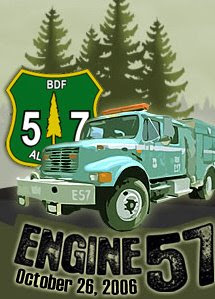
Five U.S. Forest Service wildland firefighters were entrapped and died on the Esperanza fire near Cabazon, California on October 26, 2006. Killed were engine Capt. Mark Loutzenhiser, 44, of Idyllwild; engine operator Jess McLean, 27, of Beaumont; assistant engine operator Jason McKay, 27, of Phelan; and firefighter Daniel Hoover-Najera, 20, of San Jacinto. A fifth firefighter Pablo Cerda, 23, of Fountain Valley, who was injured along with the other four, passed away on October 31.The final report is at the Lessons Learned Center.
The five firefighters comprised the crew of a wildland engine, Engine 57, from the San Bernardino National Forest. They were assigned to a state managed fire approximately 60 miles east of Los Angeles and were entrapped while protecting a structure.

Aerial attacks will resume and federal firefighters will arrive this morning to battle the 1,000-acre wildfire north of Cold Springs after it neared U.S. 395 Sunday night.
Four 20-member crews, one from the Tahoe Basin and three from the Nevada Division of Forestry, were to arrive at 8 a.m. to fight the Peterson Ridge Fire, which started about 1:30 p.m. in Crystal Canyon. No structures were threatened or injuries reported.
Firefighters stopped the blaze from reaching U.S. 395 just before 7 p.m. and held it on the west side of the freeway. Traffic was not affected, officials said.
About 150 firefighters were battling the fast-moving blaze fanned by 15 mph winds that grew from 5 acres to about 200 acres in about two hours, from a staging area at the California Department of Agriculture station near the state line.
Their "Wildfire Action Plan" can be downloaded here.The first part requires every property owner within the Wildland Urban Interface zone to adequately prepare their property against the threat of a wildfire. This includes weed abatement, the use of fire-resistant building materials and the use of fire-safe landscaping. Many aspects of this portion of the strategy are already required or recommended. The big change in the program comes in the second phase.
After homeowners have made the necessary preparations to their property, we are asking every homeowner to carefully consider their personal answer to the question: Should I leave early, or stay and defend my property?
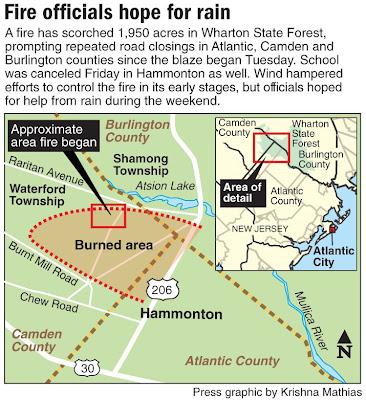 The fire, at 1,950 acres and 70% containment, has not grown for a couple of days but it is still producing a lot of smoke due to the peat soils. On Friday the smoke caused the closure of several schools. Some rain on Saturday eased the problem for a while, but until they can get massive quantities of water pumped into the peat, the next inversion may again result in closed highways and schools. Rain, unless in hurricane-induced quantities, will not put it out.
The fire, at 1,950 acres and 70% containment, has not grown for a couple of days but it is still producing a lot of smoke due to the peat soils. On Friday the smoke caused the closure of several schools. Some rain on Saturday eased the problem for a while, but until they can get massive quantities of water pumped into the peat, the next inversion may again result in closed highways and schools. Rain, unless in hurricane-induced quantities, will not put it out.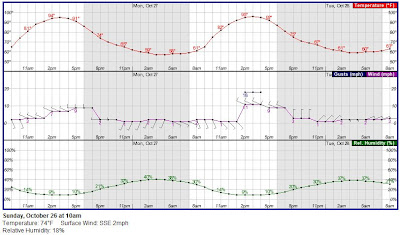


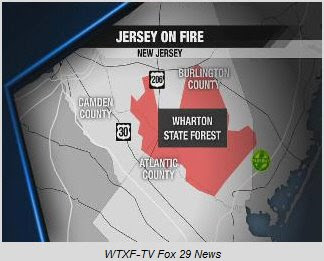

we're calling this 200 acres; 30% contained; spread has been stopped at this point; appears acreage 50% on BDU and 50% on BDF; no structures and no power lines currently threatened; we have good access to 40% of the fire; all resources actively engaged; we're looking at doing some releases within the next hour




The nighttime helicopter fire fight saved numerous homes and allowed ground resources to contain the Sepulveda Incident to 100+ acres with no injuries reported or structures lost. The Los Angeles City Fire Department sent four Bell 412 helicopters and one Bell 206L for command and control, while the Los Angeles County Fire Department responded with three Sikorsky S-70 Firehawks and two Bell 412s to assist in the nighttime battle.At least one Sikorsky Sky Crane helicopter also worked the fire after sunrise.
In addition to the 17 agency owned helicopters of the Los Angeles City and County Fire Departments, County Fire has two CL-415 SuperScoopers from the Province of Quebec in Canada, and one Erickson S-64 Helitanker on contract. City Fire also has one Erickson S-64 Helitanker on contract to assist in combating the devastating wind driven Fall fires common this time of year in Southern California.
"....the California National Guard dispatched crews with picks and shovels to the front lines from Big Sur to the Oregon border."Anyone ever used a pick on a wildland fire?
A 64-year-old Washington, D.C., man has been indicted for allowing his campfire on Ham Lake to blow out of control on a windy May day in 2007, triggering Minnesota’s largest and most expensive forest fire in 80 years.
Stephen George Posniak was indicted Monday by a grand jury in federal court in Minneapolis, some 18 months after the fire raged.
The indictment alleges that on May 5, 2007, Posniak allowed a fire of paper trash and other items to get out of control at his Ham Lake campsite in the Superior National Forest, just outside the Boundary Waters Canoe Area Wilderness.
The campfire spurred a wildfire that burned across 75,000 acres along the Gunflint Trail in Minnesota and Ontario, cost $11 million to battle and destroyed 150 buildings worth millions of dollars. No one was injured.
Posniak is charged with one count of setting timber afire, one count of leaving a fire unattended and unextinguished and one count of giving false information to a U.S. Forest Service law enforcement officer. The indictment says Posniak told officers he was camped on Cross Bay Lake, not Ham Lake, the morning of May 5.
The indictment claims Posniak told officers that he came across the already-started fire when he canoed across Ham Lake.
If convicted, he faces a potential penalty of five years in prison on the first felony count of setting timber afire and six months each for the other misdemeanor counts.
Fire modeling revealed that grazing in grassland vegetation can reduce surface rate of spread and fire-line intensity to a greater extent than in shrubland types. Under extreme fire conditions (low fuel moisture, high temperatures, and gusty winds), grazing applied at moderate utilization levels has limited or negligible effects on fire behavior. However, when weather and fuel-moisture conditions are less extreme, grazing may reduce the rate of spread and intensity of fires allowing for patchy burns with low levels of fuel consumption.Senator Larry Craig, from Idaho, questions some of the conclusions in that report. Here is an excerpt from an article in the Times-News:
Years ago, Larry Craig was among a group of ranchers who regularly improvised putting out fires that overtook their land.Senator Craig is not running for re-election this year.
"The moment a fire struck we went to put it out. Very often we had the fires out before the BLM ever got there," Idaho's U.S. Senator said. "That doesn't happen today. It's almost against the law."
Such first-hand experiences have remained etched in Craig's mind - and reinforce his skepticism of grazing restrictions, critics who say ranchers destroy land and the diminished role of ranchers in firefighting.
During a recent interview in his Washington, D.C office, Craig questioned the conclusions of a new report that found restrictions on cattle grazing in the Jarbidge area didn't really contribute to the massive, 600,000-acre Murphy Complex Fire in 2007. The report was compiled by a team from the Bureau of Land Management, University of Idaho and other state and federal researchers.
He agrees the liability issues with having ranchers participating need to be heeded. But he noted advantages to having those ranchers and expanded grazing. He said grazing could have decreased the extent of burning of riparian areas - often an eco-friendly interface between land and streams that provides wildlife habitat.
"Would grazing have helped that? Changed that scenario? More than likely it would've helped it some," Craig said, noting the lands take much longer than open space to recover. "If you use it responsibly, grazing is a substantial component in controlling the fuel loads in upland grazing lands that the state of Idaho is so well known for."
The study, released last month, found that any effect grazing, or the lack of it, had on the fire was far overshadowed by the extreme temperatures and other weather factors at the time. But targeted grazing could have the potential to affect fire behavior in "less intense" conditions and should be investigated further as another fire management tool, according to the report.
Craig, who noted he's observed first-hand range fires since he was a boy, said he found the report's conclusions on grazing "curious."
"While the study said grazing was a piece of the action they gave higher credit to all these other elements," he said. "What I look at in fighting fires and range management is, can you put it out once it starts? Are you capable for putting it out once you've gained control?"
Among the 1,646 homes destroyed in last year's firestorms, only 9 percent – 150 – have been rebuilt. Most property owners are still suffering the stress of insurance negotiations, finding a reputable contractor and pulling together enough money to replace their homes.
Some people were so underinsured that they are selling their properties, as are older residents who aren't up to starting over.
This story of slow, difficult steps is told by families throughout Fallbrook, Bonsall, Rainbow, Ramona, Indian reservations, Escondido, Poway, Rancho Bernardo, Dulzura and Potrero.
If history is any guide, these wildfire victims are in for a long haul.
The last building permit issued at the fire recovery center in Scripps Ranch, which was ravaged by the Cedar fire in 2003, was in September 2007, one month before the Guejito/Witch Creek, Harris, Poomacha, Rice Canyon and Horno fires rolled across the county.
“If anything, things may be slower than Scripps Ranch,” said Thinh Tran, a San Diego city building plan review specialist.
Wildfire recovery officials attribute the pace to the vast number of underinsured homeowners.
“There are people lacking $200,000 to $300,000 to rebuild,” said Bonnie Fry, director of the Ramona Fire Recovery Center.
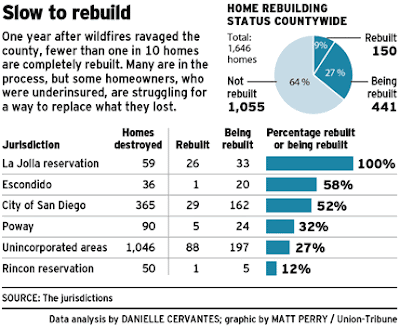
The Oregon Department of Forestry has recognized four Douglas Forest Protective Association employees for their innovative work in fire detection.Update on Li'l Smokey
The employees were presented a team award recently for their research and implementation of a video fire detection system that is receiving national attention, according to a DFPA press release.
The forestry department’s Southern Oregon area director nominated the team for the award. The DFPA employees are District Manager Melvin Thornton, Project Manager Scott Jackson, Staff Forester Dennis Sifford and Geographic Information System Specialist George Day.
Thornton began researching the camera system in 2005 because the association’s traditional lookout structures were in need of repair or replacement. Thornton sought a less expensive alternative to replacing the structures, which can cost more than $300,000, according to the press release.
DFPA began testing out the cameras in 2006 and now has eight cameras monitoring the 1.6 million-acre district. The cameras transmit video images to the DFPA office in Roseburg and sound alarms if a column of smoke is detected.
They can rotate 360 degrees every six minutes while providing an operator with the ability to zoom in for a closer look.
Each camera costs about a tenth of the price of a new lookout station.
Five cameras are also now in use throughout the Umpqua National Forest, Coos Forest Protective Association and surrounding department of forestry districts, according to the press release.
DFPA’s headquarters serves as the detection center for all the sites.

FLAGSTAFF, Ariz. (Oct. 17, 2008) -- Researchers at Northern Arizona University are discovering that some current forest carbon accounting strategies might be doing more environmental harm than good.
“Fire suppression policy and climate change are causing larger, more severe fires in many forests in the western United States, which release carbon to the atmosphere,” said Matthew Hurteau, a research associate in NAU’s Merriam Powell Center for Environmental Research.
Hurteau explained that since trees reduce climate change effects by storing carbon and not letting it loose into the air, emerging carbon accounting policies provide funding incentives for managing forests packed with trees. However, Hurteau supports thinning forests to protect them from fires that cause even greater amounts of carbon to be released into the air.
Research also suggests that forest fires release about 5 percent of total annual U.S. greenhouse gas emissions, a contribution equal to about one-third of the transportation sector.
“Current carbon accounting in California penalizes forest managers for thinning the forest because it reduces the amount of stored carbon in trees, but this same accounting does not penalize carbon emissions from wildfires,” Hurteau said. “By thinning and consolidating carbon in fewer trees, the forests are more resistant to fire spreading and becoming catastrophic.”
NAU’s research is revealing that thinning forests not only reduces the risks for catastrophic fires and the huge quantities of carbon dioxide that they release into the air, but that the thinned wood is possible fuel for electricity generation.
Hurteau used a computer model to study the century-long, tree-based carbon storage effects from eight forest treatments, with and without forest fires. The research revealed that unthinned forests did store the most carbon, but when wildfire was included, it not only reduced the number of trees available to store carbon, the fire caused a huge emission of carbon back into the air.
The research also examined four of the largest wildfires in the United States in 2002 and discovered that prior thinning could have reduced the amount of carbon released into the air by 98 percent.
 From San Diego 6:
From San Diego 6:A 15-year-old Morse High School student is in Juvenile Hall, charged with arson.The two CL-415 Superscooper air tankers leased by the county reloaded (re-scooped?) at Sweetwater Reservoir which was only 2-1/2 miles away from the fire.
According to fire officials, the boy lit a small bush on fire with a lighter in the Bay Terraces Canyon which then got out of control.
The canyon is north of Bullock Drive and east of Woodman Street in the Bay Terraces area.
Firefighters say it began spreading shortly before 2:30 Friday afternoon, threatening ridge-top neighborhoods and prompting evacuations of the campus and dozens of residences.
Tom Deguzman was one of the people who left his house. He told San Diego 6 News, "So I went out and then I notice the fire is almost close to my place -- to my yard."
Patrol officers cleared residents out of homes ringing Paradise Canyon Park, SDFRD spokesman Maurice Luque said. Administrators at the high school, meanwhile, evacuated everyone from the campus, where classes had let out for the day a short time earlier.
......The fire department's two helicopters were joined by the two Superscooper water bombers leased by the county for the fire season in making nearly continuous drops of water and fire-suppressing foam until the flames were finally knocked down.
Even after the fire was extinguished, the tanker and copter crews continued to make drops, sometimes less than 100 feet above the ground, baring their sirens as a warning just before they made their drops.
The additional drops were a precaution, Luque said, saturating the remaining foliage in the canyon to prevent any lingering hot spots from flaring up.
No homes were lost or damaged and no injuries were reported, but the outcome might have been much different if the attack had been confined to the ground, Luque said.
“Without the air support, the potential for losing homes was definitely there,” he said.

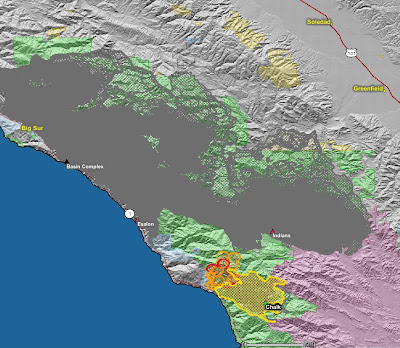
The power line believed to have sparked the Sesnon fire was not covered by strict state inspection and brush clearance rules because it was owned by a private utility on private land, according to regulators.
The California Public Utilities Commission confirmed Thursday that the electrical distribution line is owned by the Southern California Gas Co. and fell onto the utility's property. Commission rules require power lines owned by electric utilities to be inspected regularly and to have brush under the lines cleared to prevent fires. But commission spokesman Tom Hall told The Times that the rules don't extend to nonelectric utilities on private land.
"This line does not fall under PUC jurisdiction," Hall said. "But we do have a PUC inspector working with [the Gas Co.] to determine the cause."
Heavy winds blew down the distribution line in a remote unincorporated area of L.A. County north of Porter Ranch, fire officials said, sparking a huge blaze that destroyed 15 homes and damaged six, destroyed 47 outbuildings and may have contributed to the death of a motorist driving on the 118 Freeway.
"It's between the PUC and electric utility companies. We're not even looking at that," said Steve Dunn, senior civil engineer with the county Department of Public Works' utility section. "It's my understanding there's a maintenance program that's developed by electric utility companies in compliance with the CPUC."
It remains unclear whether the power line that fell had been inspected or whether the brush below had been cleared. A spokesman for the Southern California Gas Co. said only that the utility was fully cooperating with the investigation but declined to answer more detailed questions.
L.A. County Fire Deputy Chief Scott Poster, whose agency oversees brush clearance in unincorporated areas, said there are no county regulations specifically requiring brush clearance under electrical lines on private property unless the lines are near a structure.
There has been growing concern about the danger posed by power lines during the fire-prone Santa Ana winds season. Power lines were the suspected culprit behind at least five of the fires that burned across Southern California last October, including one in San Diego that consumed 200,000 acres, destroyed 1,041 homes and killed two people.
But placing lines underground is highly expensive -- with some cost estimates as high as $1 million a mile.
The utilities commission investigated last year's Witch fire in San Diego and concluded in a report released last month that San Diego Gas & Electric Co. failed to properly maintain power lines that were felled by the wind (the utility strongly disputed the finding).
 From the Daily Courier:
From the Daily Courier:PRESCOTT - When the Prescott Fire Department's Granite Mountain wildland firefighting crew members found out that they had become the first municipal Hotshot crew in the nation, they took a moment to tear the little "t" off their rig and then immediately set off on a rugged hike to the fire line in the heart of California's Klamath National Forest.
That "t" stood for "trainee," a label they had worn for two years while working hard to earn the elite title of Type I Interagency Hotshot Crew.
This season alone, they responded to 13 wildfires in four states while also helping Prescott residents create wildfire-defensible space on 95 acres around 12 homes. And they spent 2,000 hours in the classroom.
By the time they heard the big news last month via a call from the home department, they had been training for five years and waiting 3.5 months to hear whether the federal government had approved their request for certification.
Granite Mountain Hotshots Superintendent Eric Marsh was getting worried that much of his crew would disband for the season before the news arrived. Eight of the 20 members have year-round jobs.
Soon the news spread, and it felt great when other Hotshot crews that had supported their efforts told them they deserved the title.
His crew's motto comes from his college motto: Esse Quam Verdi (To Be, Rather Than To Seem).
The concept of a well-trained Hotshot crew originated with the U.S. Forest Service in California in 1947, and today 85 crews are certified. Only four are based outside of the federal government, and the other three are state or county based.
It is only appropriate for Prescott to join the Hotshot ranks, since it is the oldest city fire department in Arizona - established in 1885. The city also was the first in Arizona to adopt a wildland-urban interface building code that requires wildfire-defensible construction on homes.
GRANTS PASS, Ore. — The helicopter company involved in a crash that killed nine people fighting a California wildfire said Thursday the suspension of its firefighting contract by the U.S. Forest Service is about the weight of one of its aircraft and not about safety.
"All our aircraft are FAA compliant and airworthy," Andy Mills, director of helicopter operations for Merlin-based Carson Helicopters, said. "This is not a safety issue. It's a contract issue."
Mills said the issue was the weight of one of the 10 helicopters Carson provides under contract with the Forest Service for fighting wildfires and may be because of the calibration of the scales used to weight it. Weighing more than is specified by the contract could affect a helicopter's lifting ability, and the Forest Service has the right to suspend the contract until the discrepancy is resolved, he said.
Seven firefighters for Grayback Forestry, a pilot for Carson and a U.S. Forest Service inspection pilot died Aug. 5 when their Sikorsky S-61N helicopter crashed on takeoff. It was ferrying the crew members from fire lines in the Shasta-Trinity National Forest.
The cause of the crash remains under investigation by the National Transportation Safety Board.
The Medford Mail Tribune reported the suspension followed a determination that the firm's 10 helicopters contracted to the agency did not meet contract requirements.
Susan Prentiss, branch chief for incident support contracting at the National Interagency Fire Center in Boise, Idaho, cited "a discrepancy in the weight," but would not elaborate. Prentiss said the suspension is not linked to the fatal crash.
Most of the 10 helicopters contracted to the Forest Service returned to Merlin, where Carson will weigh them and do routine maintenance, Mills said. Some had already been released from firefighting duty as the wildfire season winds down.
The Martin Mars water bomber based in Port Alberni (British Columbia) was poised to assist in fighting raging wildfires near Los Angeles last week but instead got mired in bureaucracy, said the aircraft's owner yesterday.
Hawaii Mars has been in California since early July on a contract with the state. The aircraft landed on Lake Elsinore on Saturday, located 20 minutes from Los Angeles, after flying from its previous base at Lake Oroville in central California.
Before that, the Mars was at Lake Shasta where it worked at extinguishing numerous wildfires sparked by a lightning storm in June.
But despite its unique ability of dropping fire-suppressing foam on structures without causing damage, Hawaii Mars never got off the water last week to help with the fires near Los Angeles.
"We had our first taste of the bureaucracy of the infrastructure down there," said Wayne Coulson, owner of Coulson Flying Tankers of Port Alberni.
Fighting wildfires is an expensive proposition in California, last year costing the state $1 billion.
Last year, Hawaii Mars helped douse fires in San Diego county through its partnership with the state's forestry department. It dropped 163,000 litres of fire-suppressing gel on three fires there.
Last week's fires were all in Los Angeles county, and required a new set of negotiations for the Martin Mars to operate.
"The Mars was available, but trying to figure out how to contract it [to the county] was a major event," said Coulson. "We've never worked with L.A. county before and there's a whole group of different people and infrastructure."
However, the fire situation is under control partly due to the fact that the Santa Ana winds which normally fan wildfires were not as strong as they have been in other years.
"They normally last up to a week and this was only a short burst of a couple days," Coulson said.
Despite the lack of activity, the community around Lake Elsinore has welcomed the Martin Mars and its crew to the area off the Interstate 5 between Los Angeles and San Diego.
Hawaii Mars will return to its base at Sproat Lake in a few weeks and will remain here for the winter to undergo repairs and maintenance, Coulson said.
"We are starting to think about next year and we've got maintenance to do on the aircraft," he said.
It will take time to convince California's decision makers that the Martin Mars is safe to use on neighbourhoods threatened by wildfires, he said.
It is hoped talks over the winter make for smoother operation in California during next summer's fire season.
"We're working with everybody at all sorts of different levels," Coulson said.
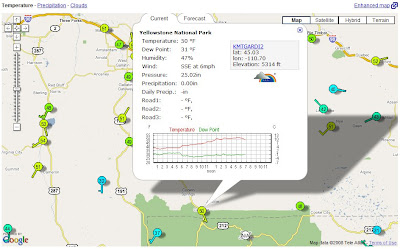 The little icons display the temperature, color-coded for ranges of temperature, and a wind barb, showing the wind speed and direction. When you click on an icon, you get additional data.
The little icons display the temperature, color-coded for ranges of temperature, and a wind barb, showing the wind speed and direction. When you click on an icon, you get additional data.What's new with iGoogle?
10/16/2008 10:01:00 AMI'm an iGoogle addict. I check my news, email, stocks, feeds and weather there and sometimes even manage to squeeze in a game or two during the day. Having everything in one place is super convenient, but I often wish I could deal with all my stuff without having to leave my iGoogle page. With today's release, I can. We've rolled out an updated design for iGoogle to all U.S. users, which includes full canvas views for gadget and support for full feed reading.
(read more HERE)
SDG&E is under fire for its proposal to shut off power during high winds in wildfire-prone areas.HERE is a link to a video news report on the subject.
At a meeting Tuesday night in front of the State Public Utility Commission, San Diegans voiced their concerns about the idea.
Also present at the meeting, county officials asked the commission for a full investigation into the matter.
"To convince the commission to do the right thing and hold SDG&E's feet to the fire to do what they should've done years ago, changing the poles from wood to steel, more spacing between the lines and better tree-trimming vegetation management," said County Supervisor Dianne Jacob.
A SDG&E representative at the meeting said the company is committed to doing whatever is possible to make its system safer.
Five years after local officials were infuriated by a decision to ground aircraft at sunset rather than attack California's largest wildfire in its infancy, the region is moving ---- albeit slowly ---- to battle blazes from the air after dark.
State fire officials said helicopters did not fly at night during this week's San Diego County wildfires, largely because pilots were able to knock down flames with water and fire retardant during the day.
But the California Department of Forestry and Fire Protection, or CalFire, has opened the door to making drops at night over the backcountry areas it is responsible for protecting, including 1 million acres in San Diego County.
And the state agency gave the city of San Diego the green light in September to fly its two twin-engine firefighting helicopters over those areas, in the event another inferno like those of 2003 and 2007 breaks out.
"CalFire has agreed to allow night flying in state responsibility areas if they determine that the equipment is safe," said county Supervisor Dianne Jacob, who represents much of the backcountry, including Ramona. "This is a historic change in policy."
While it is disappointing the state did not give a green light to the county because it does not consider its helicopters to be safe, Jacob said a future aircraft purchase, possibly with money from a November ballot measure, could put the county in the night firefighting business.
For now, said sheriff's Lt. Phil Brust, county helicopters will focus on flames during daylight hours.
"During the day, we can do any mission that is asked of us," Brust said. "But once the sun goes down, they (CalFire officials) are not comfortable flying in those helicopters."
The county sheriff helicopters are both single-engine Bell 205 models.
Division Chief Tom Humann, aviation safety officer for CalFire in Sacramento, said the state agency doesn't consider single-engine helicopters safe because, if the engine goes out, the pilot has no choice but to bring the aircraft down.
In daylight, a pilot has a 180-degree range of view to rely on for spotting an emergency landing spot, he said. But at night, even with night-vision goggles, a pilot's range is 40 degrees.
"It's kind of like looking through a couple of toilet paper rolls," Humann said.
And a pilot is much more likely to crash at night in a single-engine aircraft, he said.
WASHINGTON, D.C. – The Department of the Interior will host a multi-media presentation on wildland fire prevention and containment, featuring fire-proofing tips for homeowners and first-hand experiences of Interior firefighters, on Saturday, October 18, 2008, from 2:00 p.m. to 3:15 p.m. in the Yates Auditorium of the Main Interior Building. The public is invited to attend this free family event, entitled “Smokejumpers, Groundpounders and Shots – Tales from Wildland Fire” at 1849 C Street NW, Washington, DC 20240.
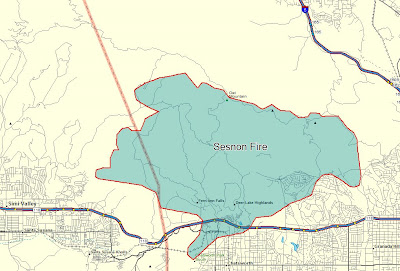

In an instant, flames surround L.A. fire crew
The captain of the trapped engine company faces life-and-death decisions as erratic winds fan canyon blaze. 'The fire exploded and started raining embers . . . It was incredible,' he says.
By Robert J. Lopez, Los Angeles Times Staff Writer
October 15, 2008
It was one of those moments firefighters fear most.
Los Angeles Fire Capt. Scott Gould was riding inside Engine 228 as it maneuvered along a winding canyon above Porter Ranch. He was talking on the radio with Capt. Richard Brunson, who was just ahead in Engine 8.
Commanding the first two units to arrive at the Sesnon fire Monday morning, the captains were coordinating their assault on the wind-whipped blaze. What had been a half-acre fire only a few minutes earlier was now 20 acres and growing.
As Brunson reached the flames along Limekiln Canyon, Gould could see that a spot fire had broken out several hundred yards below. If the new fire got going, he recalled thinking, Brunson would be trapped. Gould and his crew pulled a hose from their engine and began trying to knock down the blaze.
In what seemed like only an instant, the two captains later recalled, flames were everywhere.
"The fire exploded and started raining embers all around that canyon," Gould said Tuesday. "It was incredible. All the ridge lines were going up in flames."
Brunson, meanwhile, faced another wall of fire, fanned by winds in excess of 30 mph. He decided to try pulling back a couple miles down the road, where he and his crew could join other units to protect structures and help with evacuations.
"We went into defensive mode," he said.
But as he headed down the canyon, he saw that flames were beginning to devour brush all around Gould and his crew. Brunson jumped out of his engine and ran toward Gould.
"Drop your hose and leave!" he recalled shouting. "Get the hell out of here!"
Brunson's engine led the way down the road as Gould and his crew jumped in the cab of their truck. But it was too late. It was as if incendiary bombs were exploding everywhere, Gould said.
"It just started spotting all around," he said of the flames.
Gould weighed his options and knew they weren't good. "Engine 228 is trapped," he barked into his radio. "We're surrounded."
Firefighter Paul Clark, who was with Gould, said that the flames were on both sides of the road.
"It was safer to stay where we were," he said.
Looking at his map book, Gould radioed in his coordinates and asked for a "priority" water drop. He and his three-man crew hunkered down in the cab of their engine as flames raced around them.
The smoke was so thick the crew could see only a few feet in front of them, and the water-dropping helicopter overhead couldn't see them either.
"Can you spot the copter so we can get a drop on you?" Gould recalled the dispatcher asking.
For the next 15 minutes, Gould and his crew kept shifting their fire engine into small areas that were partially burned -- offering a bit of protection -- as the wind fanned the flames back and forth across the canyon.
"We were lucky because of the winds," Clark said. "It didn't light everything off at the same time."
In the end, Gould said, it was the erratic winds that allowed his crew to escape.
They received word from the helicopter that the road was clear. He and his men made it out and spent the rest of the day fighting the Sesnon fire.
 Bob Mutch receives the IAWF’s Wildland Fire Safety Award from president Chuck Bushey at the recent “The Fires of ’88: Yellowstone and Beyond” conference.
Bob Mutch receives the IAWF’s Wildland Fire Safety Award from president Chuck Bushey at the recent “The Fires of ’88: Yellowstone and Beyond” conference.From his early days at what was then known as the US Forest Service’s Northern Forest Fire Laboratory in Missoula, Montana to his various roles within that agencies fire management program Bob’s distinguished 38-year career has continually championed both firefighter and public safety.New Camp Pendleton Fire Forces Closure of I-5
His involvement in developing the Fire Behavior Service Center concept in the early 1980’s further illustrates his active involvement and commitment to wildland firefighter safety. Even his very early work within the US Forest Service’s wilderness fire program can now be viewed as contributing significantly to firefighter and public fire safety, while at the same time helping to change agency policy and return fire as an ecological process to wildlands.
Following his agency retirement Bob continued his fire career as a renowned wildland fire consultant promoting wildland fire safety.
A new wildfire is burning at Camp Pendleton, forcing the closure of Interstate 5 for 20 miles in both directions. CHP Officer Rob Sanchez says the freeway was closed once Tuesday morning, briefly reopened and then closed again afterUpdate on the Angel fire in San Francisco Bay
winds shifted and the fire flared up.
A North County Transit spokesman says Amtrak and Metrolink trains are being held at Oceanside and at San Clemente stations.
Marine Cpl. Priscilla Vitale says it is not immediately known how many acres are involved in the new fire, but she says no structures are threatened.
It is the third fire to start on the base in two days. Vitale says two fires started Monday on the base's training ranges; she says neither fire was caused by any type of military training. More than 3,000 acres have been scorched; there is about 25 percent containment.
An evacuation order for about 1,500 homes in Oceanside. A spokeswoman for the City of Oceanside says some residents have been allowed to briefly return to neighborhoods near the base to get their pets and collect personal items.
Marine spokesman 2nd Lt. Riley Whaling says an unknown number of families were evacuated Monday by military police from a housing area threatened by the fire.
The Juliet fire, named for the training area where it started, was reported some time after 3 p.m. Monday. It was not immediately clear how the fire started.
Whaling said a second fire was burning on the base in a training area. No buildings were threatened by that fire.
 CHRISTOPHER CHUNG / The Press Democrat
CHRISTOPHER CHUNG / The Press DemocratFirefighters working through the night on Angel Island brought the wildfire that burned more than half the island to 90 percent containment by Tuesday morning, a fire officials said Tuesday.Colorado: five homes burn near Hotchkiss
Fire crews expect to have the fire fully contained by Tuesday evening.
Crews will be on the island for the next few days, making sure no hot spots remain to threaten flare ups.
What started the wildland blaze remains under investigation.
“We’re focusing on the area on the east side, where there was a campsite. We need to interview the campers,” said Kent Julin, a forestry with Marin County Fire Department.
On Tuesday morning there was little evidence of the conflagration Monday when flames swept over half the island, created a glow in the sky and filled the air above San Francisco Bay with heavy smoke.
There was no lingering smoke Tuesday as firefighters worked under clear, blue skies, Julin said.in the bay just off the Marin County coast.
A force of nearly 400 firefighters saved the state park's historic buildings from destruction.
Tuesday, October 14, 2008West Virginia: Coal refuse fire
A wildfire that started Thursday afternoon destroyed five homes and at least a half-dozen outbuildings on Redlands Mesa near Hotchkiss before it was fully contained Sunday, Delta County emergency manager Rob Fiedler said.
Fiedler said only three of the homes were occupied.
The fire was likely caused by humans, Fiedler said, and is still under investigation.
“We had eyewitnesses who reported seeing some human activity and investigators are still checking out all leads and running them down to check the veracity,” he said. “But it has never been considered malicious from the outset.”
With 45 to 50 mph winds pushing the fire early on, it spread from 80 acres Thursday, when 34 homes in its path were evacuated, to approximately 240 acres Friday. By Friday evening the fire was 40 percent contained. No one was injured in the fire, but it took the lives of one cat and three dogs.
Fiedler said air tankers from the Bureau of Land Management dropped flame retardant on the fire Thursday and Friday. More than 100 firefighters from all Delta County fire departments fought the blaze along with a 20-person hand crew from the Buena Vista Correctional Facility.
The chance for wildfires still exists, Fiedler said.
“Things are still very dry below 8,500 feet,” he said.
(Glen Jean) -- Firefighters say there's very little they can do to stop a coal waste dump in Fayette County from burning. The gob pile caught fire about three weeks ago and has been smoldering underground ever since.Montana: Prepare, Stay, and Defend
Mt. Hope Volunteer Fire Chief Shane Wheeler says the process probably started with spontaneous combustion after the area was reclaimed with a thick coating of sawdust, replanted with vegetation.
"Pressure over time caused the coal under that saw dust to catch fire," said Wheeler.
The chief says there's really no good way to put out the fire. Therefore the strategy has been to just let it burn within a set perimeter.
"The big hazard would be the ground giving way. You walk across it and you could literally fall into a burning crevice,” said Wheeler. "There's been some cases where people have been killed trying to put them out, where bulldozers have literally been swallowed up."
Some gob piles will burn for years. The biggest danger is when the fire reaches into the air and jumps fire breaks into the forest. Right now, the leaves are dry, brittle, and littering the forest floor. The gob pile fire is about 25-acres and Sunday it jumped into a nearby woodlot, taking out another 25-acres of woods.
Wheeler says the best they can do is continue to improve the fire line they've cut around the perimeter and hope it holds the fire to the interior.
Just thought I'd update you on the presentation at the Idaho Wildland Fire Conference in Boise this week. Keith Harrap (Executive Director Ops/Support, New South Wales Fire Service) and I were the keynote speakers and covered the Australian Prepare, Stay, and Defend system for wildland fires. Idaho State Lands really is ahead of the pack on this.Thanks Alan--we're glad it went well. We used to call it "Shelter in Place", but Prepare, Stay, and Defend is a better term.
About a month ago, Steve Kimball sent out the Tasmanian "Bushfire" DVD to all fire chiefs and county commissions, so the audience was primed to hear the details. Keith covered the big picture of how Australia has dealt with the issue and their great success at reducing deaths, injuries, and loss of property by preparing homes (FireWise) and having people stay at home to keep their homes from burning. I related our fire company's success at implementing this system in our small Montana community of Painted Rocks. There were around 250 attendees representing the bulk of Idaho's fire services.
The message was very well received and Idaho is on its way to finding better ways of protecting its communities. Idaho Lands really deserves a pat on the back for their proactive efforts.
Alan Tresemer
Batt. Chief
Painted Rocks Fire & Rescue, Montana
Visit our new Wildfire Today Store to see a full range of books, electronics, weather instruments, and headlamps for wildland fire personnel.